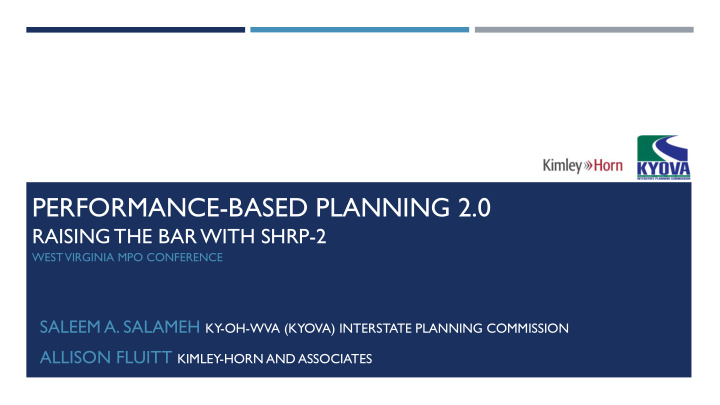



PERFORMANCE-BASED PLANNING 2.0 RAISING THE BAR WITH SHRP-2 WEST VIRGINIA MPO CONFERENCE SALEEM A. SALAMEH KY-OH-WVA (KYOVA) INTERSTATE PLANNING COMMISSION ALLISON FLUITT KIMLEY-HORN AND ASSOCIATES
AGENDA • Introduction • Prioritization Process Review • SHRP-2 Overview • KYOVA Performance Measurement T ools • Action Plan • Closing Thoughts • Acknowledgements • Questions? 2
INTRODUCTION Who is the KYOVA Interstate Planning Commission? 3
HUNTINGTON, WV-KY-OH URBANIZED AREA TRANSPORTATION MANAGEMENT AREA TMA designation in July 18, 2012 TMA Population – 202,637 (urbanized) MSA Population ~ 365,000 (also includes 1 other county in WV) KYOVA Planning Boundary grew Now includes Boyd and Greenup counties in Kentucky and Putnam County in West Virginia RIC, the MPO in Charleston is taking the lead in planning responsibilities for Putnam County 4
TMA REQUIREMENTS – WHAT’S BEEN DONE Congestion Management Process Completed January 2013 Integrated MTP In progress Expectations: strong emphasis on Freight Planning Expected by Spring 2017 Integrated TIP Completed April 2015 5310/5307/5339/5340 Designated Recipient Integrated Travel Demand Model 5 Certification Review – April 19-20, 2016
FEDERAL PLANNING GOALS Goal Area National Goal Safety Reduce fatalities & serious injuries on all public roads Infrastructure condition Maintain a state of good repair Congestion reduction Significantly reduce congestion on the NHS System reliability Improve the efficiency of the surface system Freight movement & Improve the national freight network, access of rural economic vitality communities to markets, & economic development Environmental Enhance system performance while protecting and sustainability enhancing the environment Reduced project delivery Accelerate project completion by eliminating delays in the delays project delivery process 6
PERFORMANCE MANAGEMENT WITH SHRP-2 7
WHAT IS SHRP-2? (SECOND STRATEGIC HIGHWAY RESEARCH PROGRAM) Products developed from objective, credible research. Solutions that respond to transportation community challenges – safety, aging infrastructure, and congestion. Tested products, refined in the field. Focus on Safety, Renewal, Reliability, and Capacity SHRP2 Solutions offer new technologies and processes 8 to enhance the efficiency of transportation agencies.
PERFORMANCE MEASUREMENT FRAMEWORK Topics and Factors Considered in the Framework: Transportation Environment Economic Community Cost Mobility Ecosystems, Economic Land Use Cost Habitat, and Impact Reliability Archeological Cost- Biodiversity Economic and Cultural Effectiveness Accessibility Water Quality Development Resources Safety Wetlands Social Air Quality Environmental Justice Climate Change Environmental Health 9
PERFORMANCE MEASUREMENT FRAMEWORK (CONTINUED) Actions Addressed at Each Stage: Environmental Long-Range Corridor Planning Programming Review Planning Develop project Develop, refine, and Set goals and Select projects for concepts. evaluate alternatives. objectives. design. Conduct broad-based Identify preferred Monitor systems. Select projects for impact analysis (“red alternative. construction. Understand high flags”). Identify localized priority concerns. Set corridor-specific impacts. Assess system-level objectives. impacts. 10
PERFORMANCE MEASURES WORKSHOP FHWA-facilitated two day workshop Federal, state, regional, and local participants Understand the history and intent of SHRP-2. Understand and be able to practically apply the elements of Performance Measures for Highway Capacity Decision-Making . Participate in break- out group brainstorming to generate ideas on future “action steps.” Collectively decide upon the framework and components of an Action Plan. Collectively decide upon “next steps” for developing and implementing the Action Plan. 11
REGIONAL CHALLENGES TMA includes a neighboring MPO with separate planning and modeling tools KYOVA combined with a previously separate MPO and integrating planning and modeling practices Working with disparate data sources Different levels of detail Different attributes Different state requirements Different update schedules 12
REGIONAL OPPORTUNITIES Consistent approach over the tri-state area Opportunity to build synergy between agencies Application for new regional data and plans Maintainable by KYOVA and within available budget parameters 13
PERFORMANCE MEASUREMENT TOOLS A Spatial Decision Support System (SDSS) A GIS-based system of relational databases, computational tools, and information sources used to Store transportation system attribute and performance data Perform technical analyses that identify/quantify congestion and assess the effectiveness of congestion reduction/mitigation strategies Provide thematic maps and system performance reports for stakeholders and decision makers 14
WHAT IS A SPATIAL DECISION SUPPORT SYSTEM (SDSS)? Spatial Data Management Easy to use, Iterative interactive Problem user interface Solving Semi or ill- SDSS structured Spatial problem Modeling Characteristics solving Report Visualization Generation Scenario Evaluation 15
FACILITATE CONGESTION MANAGEMENT PROCESS (CMP) REPORT FIGURE GENERATION 16
DEVELOP A TOOLBOX TO FACILITATE WORKFLOW 17
TOOL #1: UPDATE MAP DATA 18
TOOL #2: IMPORT KYOVA MODEL LINKS 19
TOOL #3: EXPORT MXD TO JPEG 20
TOOL #4: UPDATE MAP TEMPLATE AND EXPORT 21
HOW DOES KYOVA USE THE SDSS? MAP FIGURES MAP FIGURES KYOVA Transportation Management Area Boundary Volumes from Traffic Model Assignments CMP Network Capacities from Traffic Model Assignments Major River Crossings V/C Ratios from Traffic Model Assignments Fixed Route Transit Coverage Levels of Service Computed Crash Rates Compared to Statewide Average Travel Time Indices Congested Locations from Stakeholder Workshops Planning Time Indices Downtown Railroad Underpass/Viaduct Locations 22
ACTION PLAN 23
PROGRAM-LEVEL GUIDING STATEMENTS Safety – Increase safety for all users. Infrastructure Condition – Maintain the existing transportation network in a state of good repair. Congestion – Manage and reduce roadway congestion where appropriate. Goods Movement – Facilitate timely and efficient movement of freight both within and through the region. Environmental Impacts – Reduce or mitigate negative environmental impacts. Multimodal Accommodations – Promote a multimodal travel environment. Economic Vitality and Livability – Influence positive economic impacts through enhancements in livability for residents, employers, and visitors. 24
ACTION PLAN STEPS Consider emerging federal and state performance measurement benchmarks Finalize program-level guiding statements Establish working groups to help define project-level performance measures Create a maintainable data strategy Revisit the action plan as milestones are achieved 25
CONTINUING APPLICATIONS Finalizing tri-state travel demand model Building on the regional SDSS Metropolitan Transportation Plan Update Transportation Improvement Program Update Monitoring the CMP Small area or multimodal studies 26
QUESTIONS? 27
CONTACT INFORMATION Saleem Salameh, Ph.D., P.E. T echnical Study Director/Deputy Executive Director KY-OH-WVA (KYOVA) Interstate Planning Commission ssalameh@kyovaipc.org Allison Fluitt, AICP, P .E. Senior Transportation Planner Kimley-Horn and Associates allison.fluitt@kimley-horn.com 28
Recommend
More recommend